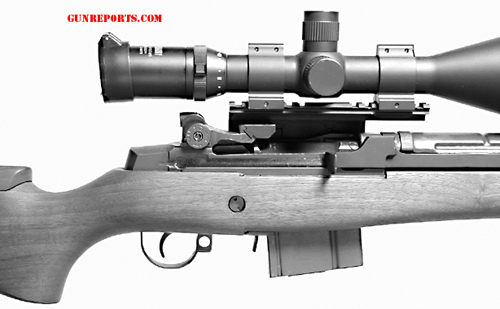Per the company website, the M21 Tactical had a Douglas Premium barrel with 1:10 inch twist, with optional Hart or Krieger barrels available on special order. The two-stage trigger broke at about 4.9 pounds. Springfield has made enough M1As that it really knows how to put together a decent rifle, which this one surely was, so when the rifle performed perfectly with no malfunctions we were not at all surprised.
This was a serious-looking rifle, mostly because of the Springfield’s pleasant-looking wood stock of plain but straight-grained walnut. The stock had a decent non-glare finish. It was fitted with an adjustable cheekpiece that could be raised by inserting an Allen wrench into the right side of the stock. We noted that while lefties could use it, this stock would not be as pleasant for them as the McMillan, especially if the articulated portion were raised.
Courtesy

The price above does not include a scope. Our test rifle was equipped with Springfield’s own 4-14X56-mm Japanese-made scope labeled as “3rd Generation Government Model,” with green-illuminated reticle and 30 mm tube ($869). The scope had an interesting reticle that included tiny hold-over dots for long-range shooting with match ammunition, and a built-in and unobtrusive bubble level at the very bottom of the sight picture. The scope hood would add to the cost, as would the mounts and rings ($139). The attached Harris bipod was listed at $72. That comes to a total of about $4,075 as tested. Note that if you add $600 for a McMillan stock as fitted to the Fulton, the two rifles cost about exactly the same.
The scope was mounted to a thick aluminum plate that attached to the action via two thumbscrews and also attached to the clip-loading slot, similar to the ARMS mount on the Fulton, and to the Brookfield. The 30 mm rings were also aluminum. The scope was fitted with a forward hood and hinged Butler Creek covers fore and aft. The rear cover opened by pressing a button. The rifle also had NM-type iron sights front and back.
Gun Tests

There was no provision for altering the length of the stock, which had a pull of 13.6 inches. The butt had a trestle-style rubber butt pad with white-line insert. The forend cover was brown. The rifle had a Harris bipod attached, and a single sling swivel beneath the butt, with no place to attach a sling at the front. We noted that the Harris bipods came loose from both rifles to which they were attached, during the course of our testing. The small screw that secures it needs to be firmly tightened to prevent this.
The Springfield’s action was glass-bedded to the stock, as were the other two rifles. Both the Springfield and Armscorp stocks mimicked the military version, but were fatter everywhere and had no provisions for increased traction in the grasping areas.
The Springfield M21 Tactical had a rear lug, but the stock was not secured to it with a screw, as were the other two rifles. Though the overall performance was more than adequate, we wondered if accuracy would improve with the addition of that screw.
We did expect a bit more accuracy than we got, which was best with Federal’s excellent Gold Medal Match ammunition. Average three-shot groups were 1.2″ at 100 yards. Again we used the bipod and a rear shot-filled leather bag for all test shooting.




























